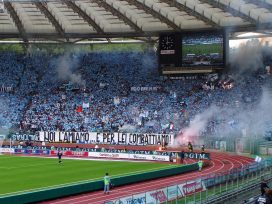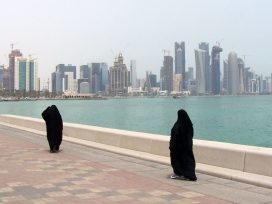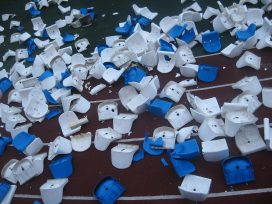As London struts its stuff for the Olympics and calls to the world to attend its show, what kind of account of who we are, who we were and who we want to be will it celebrate? Danny Boyle’s dramatisation for the opening ceremony is planned as a spectacular remake of Britain’s “island story”, drawing its inspiration and strap-line from Caliban’s famous speech in The Tempest, in which he urges his companions:
Be not afeard: the isle is full of noises
Sounds and sweet airs that give delight and hurt not.
Boyle’s “Isle of Wonders” seeks to conjure up a vision of Britain as just such an enchanted island, a latter day Illyria, where the descendants of Caliban energetically disport themselves, demonstrating a “can-do” attitude that enables them to defy gravity, become authors of their own lives, and above all “live the dream”. And not a Prospero in sight to spoil their fun.
Critics have often read The Tempest as a parable about the all too material dreams of maritime Empire, with Prospero as the coloniser against whom Caliban’s voice and vision protest. They would have therefore been somewhat bemused to learn that the Tempest theme encapsulates the “heritage, diversity, energy, inventiveness, wit and creativity” that defines the post-imperial, multi-national society that Britain has become. Shakespeare certainly gives Caliban some good lines – although Ariel has better and perhaps better represents the spirit of inventiveness, wit and creativity – but the last word about the nature of the play is definitely reserved for Prospero as the author’s valedictory messenger.
Much then depends on how Caliban’s speech is contextualised by Boyle, now that Prospero, his main adversary, has been written out of the plot. Some at least of Britain’s back story has to be told in the opening ceremony, and this must be about roots as well as routes. But how much of the old Churchillian version of the island story could possibly survive its post-colonial translation? Perhaps just enough to satisfy the Tory Party and its cultural establishment that the invented traditions of British-Islishness are still part of the national heritage, if not yet back at the heart of the school curriculum.
So in principle, if not in practice, Boudicca and Hereward the Wake might get to audition for walk-on parts as freedom fighters. There could be a cameo role for Robin Hood (alias that puckish trickster Robin Goodfellow) and his Merrie Green Men as eco-warriors. But to go back to Bede and Beowulf, the Adventus Saxonum, and a history of the English as a chosen people, a lost tribe of Israelites, crossing the channel as if it were the Red Sea and discovering they are back home in Canaan? Surely a bit too Anglo-centric for modern tastes. If you prefer an alternative, Celtic, foundation myth, how about asking Merlin to conjure up the Arthurian legends? It would then be possible to insist, with Geoffrey of Monmouth, that Britons are the descendants of Brutus, the well known ex-Trojan and honorary Celt, grandson of Aeneas, who no sooner discovers “Albion” as his very own white and promised land, than he re-names it after himself.
If these mythographies seem just too obscure and ethnocentric to be useful for a modern nation-building narrative, what about Magna Carta, 1066 and all that? Surely the legacy of the freeborn Englishman can be made to stretch to include others under the ancient shade of Liberty’s tree? But as for King Alfred burning the cakes and Canute trying to hold back the tide of history, Drake, Raleigh, Nelson and the crew of HMS Britannia, not to mention Gloriana, Queen Victoria and all the other folk heroes who used to populate the school history books when the map was still coloured red – they had better resign themselves to the fact that they are surplus to requirements and have been pensioned off.

Dreams and nightmares
The implicit argument in adopting the island as an organising theme is that Britain’s story has been about place, not race. But for much of the time the two have been inextricably linked. How possible is it to “decolonise” the story and make it fit for Olympic purpose without it unravelling altogether? The conventional answer is that it is possible to show that from very early on Britain has been a multicultural society, and the English “a mongrel people”; and the sea, far from being a “fortress built by nature” and a “moat defensive”, safeguarding the country from invasion by alien cultures, has carried traffic between these shores and the rest of the world from the time of the Romans onwards.
The great convenience of this storyline from the point of view of assembling an account which can serve as a template for the 2012 story is that it traces a straightforward principle of continuity between Britain’s past, present and future, and enables moments from many disparate histories to be brought together to form a kind of mosaic. This suits the format of the opening ceremony presentation, which requires a strong but simple narrative to frame a dazzling stylistic bricolage, combining many different idioms to create a spectacular kaleidoscope of images. This also involves editing out, on aesthetic as well as ideological grounds, any element that is too discordant or disturbs the mix of “sounds and sweet airs that delight and hurt not”.
It is interesting that the formula for this kind of approach was first spelt out by Alexander Pope in the early eighteenth century, in his poem “Windsor Forest”, in the following terms:
Not chaos like together crush’d and bruised
But as the world, harmoniously confused
Where order in variety we see
And where, tho all things differ, all agree.
Pope here enunciates the classical concept of concordia discors (the composition of discordant elements – earth, air, fire and water – into a harmonious universe) as an aesthetic principle that should govern English pastoral poetry and landscape painting.
One way of accentuating the different elements topographically was to compose a picture around a dramatic feature: a ruined castle, a fallen oak, a waterfall or river, some human figures at work or play. For this purpose it was necessary to find a commanding view over the countryside, a prospect, as it was called, from which vantage point the pictorial space could be so organised. This introduction of variety, or irregularity, whether in the form of the picturesque or the sublime, served to unsettle what otherwise might have been a too predictable and even monotonous picture of an harmonious world; it added a new and more dynamic element to the landscaping of Englishness. The land no land may touch – the powerful image of the providential island home conjured up by the Elizabethan poets – now had to recognise that it could not insulate itself from the differences that were in play within it. Indeed it was this very principle of variety that constituted its unique character.
Translated from the field of aesthetics to that of governance, the implications of the principle become clear: it is the English ruling class who will provide the order, the commanding view which composes the political and social scene; and the Others, of whatever description, who will furnish the variety, the dramatic element of contrast within it. This is the essential formula of English multiculturalism, which draws a continuous line – of first tolerance and then celebration of difference – through the fraught circumstances of what came to be known as “community relations”. Yet the need to sustain a political and social order based on an organic sense of the nation and its imagined community – where “tho all differ, all agree” – has increasingly come up against the need to create a space of representation that is open to the not always harmonious “confusion” of the world.
This conflict remains central to the problem of how to represent the story of Britain today. The function of the opening ceremony is to transport us into another world, where the ideals of Olympism take on a local habitation and a name. The Games are meant to provide a brief interlude of enchantment, where the poetry of athleticism and the spectacle of contest can prevail in what is otherwise an all too mundane project of urban regeneration dominated by protocols of public accountancy. The choice of the island as a vehicle for the 2012 story is thus singularly apt. Islands in their very self-containment are purpose-built for the imagining of other possible worlds. But if they are the very stuff that dreams are made on, they also serve to express the darker aspects of the collective psyche. As The Tempest reminds us, islands are there to be colonised. From the Navigatio of St Brendan to Gulliver’s Travels, the quest for a lost island paradise, for an Isle of the Blessed, has linked the spiritual journeys of Western Christianity to the founding myths of nations and the profane motivations of maritime conquistadores. St Brendan was the patron saint of the Hanseatic League, after all; while, today, small and no longer remote offshore islands have been transformed into tax havens for the super rich whilst continuing to be marketed as the “other Eden”.
Some people’s dreams become other people’s nightmares (ask Caliban), and islands have also been the location for some of the most terrible things that have happened to humankind. They have often been places of abandonment, exile and confinement. W or a Memory of Childhood, George Perec’s dystopian fable about the Olympics as a struggle for the survival of the fittest, is set on an island off the coast of Tierra de Fuego. Here, in a society dedicated to the pursuit of the Olympic ideal, where every aspect of life is dictated by the Games, the victors are feted and grow rich and strong, while the losers are fed on a starvation diet, lose the will to compete and die.
This negative dialectic has a direct relevance to events much closer to home. When London’s campaigners for the 2012 Games urged the country to back the bid by “living its dream”, they could not have dreamt in their wildest nightmares that the day after winning the bid London would be attacked by terrorist bombers, and that public jubilation would come so quickly to grief. Nor could the twentytwelvers have imagined, when in happier times they invented an imaginary city in which “everyone is a winner”, that the banking system would collapse and the economy plunge into recession. In consequence, some of the noise the isle is now full of may express hurt and anger on the part of those who feel they have lost out, and have nothing to lose if the Games were to fail. We may well be concerned about their disaffection.
Looking on the bright side
In creating its spectacle of enchantment, the Isle of Wonders necessarily has to exclude all such considerations. Instead it enjoins us to look on the bright side of life. In the history of art and literature this strategy has a name. It is called kitsch.
 The advent of Olympic kitsch is usually associated with the glitzy presentation at the opening of the 1984 Los Angeles Games, which led commentators to talk of the “disneyfication” of the Olympics, not only because certain Disney characters appeared in it, and its special effects were straight out of Star Wars, but because its storyline and presentation had a certain quality of arch sentimentality. This development is usually seen as symptomatic of the Olympics having become a global media spectacle, and – from the purists’ point of view – desecrated by commercial values. What has been less remarked upon is how the aesthetics of the opening ceremony have been transformed by developments within the arts and the advent of postmodern notions of narrative.
The advent of Olympic kitsch is usually associated with the glitzy presentation at the opening of the 1984 Los Angeles Games, which led commentators to talk of the “disneyfication” of the Olympics, not only because certain Disney characters appeared in it, and its special effects were straight out of Star Wars, but because its storyline and presentation had a certain quality of arch sentimentality. This development is usually seen as symptomatic of the Olympics having become a global media spectacle, and – from the purists’ point of view – desecrated by commercial values. What has been less remarked upon is how the aesthetics of the opening ceremony have been transformed by developments within the arts and the advent of postmodern notions of narrative.
The concept of kitsch has for much of its history been little more than a term of abuse. As originally defined by Clement Greenberg, it refers to the degradation of avant garde or “high” art by the advent of the “synthetic pleasures” of popular culture; it is synonymous with “poor taste” or “commercial values” in the eyes of conservative defenders of elite culture, and seen by traditional left-wing critics as symptomatic of false consciousness and the commodification of art. But a new cutting edge was given to the term by Milan Kundera in the 1970s, when, in The Unbearable Lightness of Being he defines kitsch as “whatever denies or excludes the negative aspects of life and satisfies the need to gaze into the mirror of the beautifying lie and be moved to tears of gratification at one’s own reflection”. Kundera was thinking about the way totalitarian societies promote “regimes of happiness”, but the concept could apply just as easily to the forms of self regard promoted by our contemporary consumer culture.
It was through this culture that kitsch was rehabilitated and given a make-over by post-modernists keen to relate to the popular aesthetics of everyday life. In the work of the pop art movement (especially Andy Warhol), as well as in more recent work by Jeff Koons, Claes Oldenberg and Robert McCarthy, we see kitsch invested with artistic signature – albeit one which rejects canons of good taste and authenticity through the use of cheap synthetic materials, garish colours or special technological effects to emphasise the unsettling or surreal aspects of kitsch. In fact surrealism itself had already gone kitsch in the work of Salvador Dali. Kitsch has also been appropriated by a gay aesthetic and worked up into an idiom of high camp, as in Matthew Bourne’s all-male version of Swan Lake. In its post-modern version, then, kitsch has become cool and chic, providing a gloss on its own sources in popular culture. We might call this “high kitsch”, to indicate its evolution into a sophisticated medium invested with aesthetic value, which can put a stamp of cultural approval on idioms that are otherwise regarded as meretricious.
High Kitsch is an idiom that is well suited to creating an artificial paradise and giving it a spectacular form – which is what the “Isle of Wonders” is all about. The quotation and pastiche encouraged by the medium allows otherwise irreconcilable messages to be seamlessly woven together to create a narrative that plays as well to an internal audience, which instantly recognises the references, as it does to outsiders, who simply appreciate the kaleidoscopic effect. Given such versatility, the format provides a powerful device for mediating between the requirements of a global branding strategy and the cultural heritage claims of local stakeholders.
In Beijing elements of popular patriotic pageant, associated with the nation-building story, were choreographed within a carefully historicised “ethnoscape” and presented in cinemascope. In London, Boyle’s remake of The Tempest is planned to involve a rather different mix of ingredients, featuring ballet dancers, painters, “zorbing” balls that roll over the crowd, BMX displays, lasers, “cyclists with wings” and a large bell. It will offer a smorgasbord of “moments”, loosely connected to a suitably multiculturalised version of “our island story”, in a style that is witty, exuberant, streetwise, funky, but above all “magical”. As the string of adjectives suggests, this approach requires a delicate sampling of cultures and a fine stylistic touch; just how easy it is to get it wrong was demonstrated in the brief preview of the host city story shown in Beijing, which featured a double-decker London bus, a bizarre assortment of “Londoners” and the spectacle of David Beckham kicking a football into the crowd.
Whatever the exact details of its final content, The Isle of Wonders promises to offer us a mirror of collective self regard, a paradigm of British identity, that, in its very mode of enchantment, cannot be other than a beautifying lie, especially if it moves us to tears of gratification. For it celebrates a world in which there are no Prosperos, even though the Olympic stadium on opening night will be packed full of them, and indeed without them the Games could not take place.
Alternative readings
But is there another reading of Shakespeare’s play that offers us an alternative prospect on the Olympics and its legacy? In principle the Tempest theme could introduce a dimension of meaning that goes beyond the in-your-face artifice of kitsch, especially if it is seen as a tragi-comedy and not a romance. Harold Bloom argues that the play is about the ways in which the power of the imagination is corrupted by the imagination of power, and this would seem to have something pertinent to say about what has happened to the Olympic Dream. Still, the play remains a tricky point of reference, open to multiple interpretations. Caliban may have become a hero of post-colonial literature, but in his fury and abjection he cuts a tragic and a comic figure, cursing the language that Prospero taught him and reducing it to guttural cries and groans. Ariel, who is adept in the subversive art of mimicry, is perhaps a better guide to the delicate manoeuvres through which colonial subjects seek to extricate themselves from their cultural predicament.
Derek Jarman’s “queer” version of The Tempest, set in a crumbling gothic mansion on the bleak, windswept Northumbrian coast, offers yet another approach. Despite moments when it becomes a bit of a gothic romp (one critic described it as “Carry on Camping meets Frankenstein”), the film is a serious attempt to explore the play’s imaginative hinterland of desire and power, in cinematic rather than theatrical terms. The master/slave relationship and triangular interplay of Prospero, Caliban and Ariel becomes an allegory of homo-erotic, rather than colonial desire, with the suggestion that both Caliban and Ariel are split off and repressed aspects of Prospero’s own personality – his Jungian “shadows”. The gothic aspect adds an appropriately sinister dimension to the portrayal of Prospero’s role as necromancer, mad scientist and scholar recluse.
Although Boyle has recently directed Frankenstein on stage at the National Theatre and imported one of its props (the bell) onto the Olympic set, his interpretation, constrained as it is by its presentational form and aspirational charter, is unlikely to offer a transgressive, Jarmanesque or gothic version of its chosen theme. Its point of reference is far more likely to be Peter Greenaway’s Prospero’s Books, with its glossy hi-tech look, lavish crowd scenes and kaleidoscope of images created digitally using a Graphics Paintbox.
But Gothic London could certainly offer further inspiration: its artistic tradition has long produced a powerful counter-narrative to official guides to the capital’s heritage and the ever-onwards march of its modernities. Beginning with William Blake’s “furnaces of affliction” and “stupendous ruins”, a picture is drawn of the capital as “Babylon”, devouring the lives of its inhabitants through its monstrous appetite for growth. The gothic imagination, from Blake to Dickens, to Elisabeth Bowen, Michael Moorcock, Peter Ackroyd and Iain Sinclair, has played an important role in exploring the hidden layers of meaning embedded in the city’s fabric, haunting its memoryscape with spectral presences that speak tragically and sometimes scandalously of those who arrived thinking its streets were paved with gold, only to discover it was the graveyard of their hopes and dreams.
It is interesting to speculate what would happen if such a perspective were to be applied to constructing the 2012 Olympic story. It would, of necessity, be a very site-specific work, summoning up the ghosts of the area’s past – from Annie Besant and the Bryant and May “match girls” striking a light, to the scrap-metal merchants, second-hand car dealers and other dodgy characters who occupied the area during its final pre-Olympic days. Then perhaps it would make visible the “hidden hands” whose labour has transformed the brownfield site into its present, greener, state, telling their story in words, sounds and images. And the grand pyrotechnic finale would be soundtracked by the Clash’s apocalyptic anthem: “London calling the zombies of death/ … The Ice age is coming, the sun is zooming in/Meltdown expected, and the wheat is growing thin … London is drowning …”. Meanwhile, the Olympic site’s future as a ruin would be prophetically depicted: the long-abandoned stadium quietly rusting in the sun, Anish Kapoor’s Orbit Tower leaning even more crazily now that its observation platform has been wrecked, and the vandalised Aquatic Centre, now used to store the fresh drinking water that is taken by cart each day to the outlying suburbs where what remains of London’s population ekes out a precarious existence…
Such a scenario is of course an impossibility. To put down Michael Moorcock’s Mother London and pick up a copy of the latest instalment of LOCOG’s London 2012 Report is to wake up out of a nightmare into a world full of happy smiling faces, where the sun is shining and there is always vitamin-enhanced, sugar-free, honey for tea.
The legacy
When Prospero leaves the island, and Caliban is back in charge of his beloved isle, its spell remains for him unbroken. Yet though he may be king, he knows the limits of his dreams:
in dreaming,
The clouds methought would open, and show riches
Ready to drop upon me, that when I waked,
I cried to dream again.
He knows that the dreamed-of bounty exists only in his imagination. If he has now been enrolled for our version of the Olympic dream, it may be as well to remember this.
When Prospero takes his leave of the island and relinquishes his magical control over its affairs, he also famously recognises that his legacy may disappear with him, and “melt into thin air”:
And, like the baseless fabric of this vision,
The cloud-capp’d towers, the gorgeous palaces,
The solemn temples, the great globe itself,
Yea, all which it inherit, shall dissolve
And like this insubstantial pageant faded,
Leave not a rack behind…
For Prospero plc and the twenty-twelvers this is not an option. They are in the Olympics for the long haul, and for them an enduring legacy is paramount. What 2012 leaves behind in terms of the facilities of the Olympic Park, and the regeneration of East London is what counts, not the actual games themselves. So what is to become of us after the thirtieth Olympiad of modern times is over? Will we live happily ever after?
Boyle includes the future in his prospectus, but its lack of substance in his pageant is telling. He may have waved a magic wand and banished Prospero from his Isle of Wonders, but the minute the Olympic flame is extinguished the old sorcerer will be back in town with his whole posse, up to his corporate neck in post-Olympic schemes. His mission now is to make sure the cloud-capp’d Orbit Tower, the solemn temple of the stadium and all the other “gorgeous palaces” are put to profitable use, so that the 2012 vision, far from being baseless, becomes firmly embedded in the urban fabric. And when it comes to officially evaluating the Games, it is Prospero who will once more have the last word, not Caliban.
In the make-believe islands we inhabit as children, legacy is not a problem. These are once-upon-a-time places where people go to become castaways, have adventures, discover treasure and then come home again to get on with tea and the rest of their lives. The Olympics also used to be like that – once upon a time – but now that they have grown up and become serious business they go on for ever. The deadline for delivering the full London Olympic legacy is now 2020 and counting – if only in the hope that between now and then the economy will pick up and deliver the goods. In the meantime the soap opera version of the Olympics, like East Enders, will run and run.
Soaps, with their permanent “to be continued” signs, are made for people who no longer believe in happy endings and so don’t want the story to ever stop. The Olympics seem to promise us an opportunity to enter an enchanted world where we can go on and on “living the dream” and so live happily ever after. That is their beautifying lie. And yet for all the hype and kitsch there is still something genuinely moving – and that means both tragic and comic – about the excess of ambition, the refusal to compromise with reality, that the whole project entails. And that is what, finally, will make London 2012 a story worth telling, and the Isle of Wonders quite possibly a never to be forgotten moment.


 The advent of Olympic kitsch is usually associated with the glitzy presentation at the opening of the 1984 Los Angeles Games, which led commentators to talk of the “disneyfication” of the Olympics, not only because certain Disney characters appeared in it, and its special effects were straight out of Star Wars, but because its storyline and presentation had a certain quality of arch sentimentality. This development is usually seen as symptomatic of the Olympics having become a global media spectacle, and – from the purists’ point of view – desecrated by commercial values. What has been less remarked upon is how the aesthetics of the opening ceremony have been transformed by developments within the arts and the advent of postmodern notions of narrative.
The advent of Olympic kitsch is usually associated with the glitzy presentation at the opening of the 1984 Los Angeles Games, which led commentators to talk of the “disneyfication” of the Olympics, not only because certain Disney characters appeared in it, and its special effects were straight out of Star Wars, but because its storyline and presentation had a certain quality of arch sentimentality. This development is usually seen as symptomatic of the Olympics having become a global media spectacle, and – from the purists’ point of view – desecrated by commercial values. What has been less remarked upon is how the aesthetics of the opening ceremony have been transformed by developments within the arts and the advent of postmodern notions of narrative.




